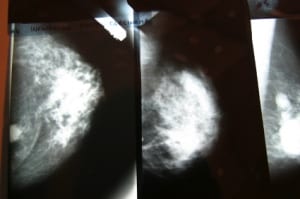
Mammography is a common imaging method used to screen for breast cancer, the second most common cancer in women. The result of a mammogram is a simple black and white image of the tissues that make up the breast. But even an image displaying apparently healthy breast tissue may still show signs that could be useful in assessing risk for breast cancer. It turns out that density — the proportion of dense (white) areas that appear on a mammogram — matters. In the last decade, research has revealed that women with high mammographic density (>75% dense tissue on a mammogram) have four to five times higher risk for breast cancer.
Characteristics such as age and BMI can affect mammographic density, but it’s estimated that over 60% of the variability in mammographic density is due to genetic factors. In an effort to identify these genetic factors, a multi-national team of researchers searched for genetic variants linked to this trait in 7,712 European women with known breast density. In results published recently in Nature Genetics, the researchers identified a variant in a gene called ZNF365 that is correlated with breast density. They found a variant associated with a 2% decrease in mammographic density. This association of with breast cancer replicated a similar result found by another research group in 2010.
While the authors state that the effects of may only account for a fraction of the of the variability in mammographic density, they note that this seemingly small decrease in density is also associated with a meaningful decrease in breast cancer risk. Although the data from this study suggests that genetic variation in ZNF365 could be affecting breast cancer risk by influencing mammographic density, further research is required to confirm this finding and to determine the other genetic factors that are involved.